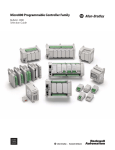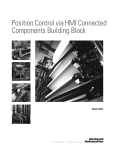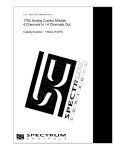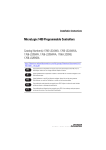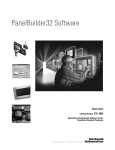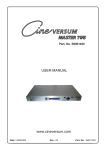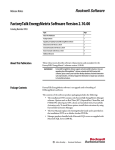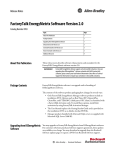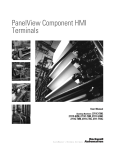Download CC-QS021 - Rockwell Automation
Transcript
Energy Management Connected Components Building Block - W.A.G.E.S. Energy Solution Quick Start Important User Information Solid state equipment has operational characteristics differing from those of electromechanical equipment. Safety Guidelines for the Application, Installation and Maintenance of Solid State Controls (publication SGI-1.1 available from your local Rockwell Automation sales office or online at http://www.rockwellautomation.com/literature/) describes some important differences between solid state equipment and hard-wired electromechanical devices. Because of this difference, and also because of the wide variety of uses for solid state equipment, all persons responsible for applying this equipment must satisfy themselves that each intended application of this equipment is acceptable. In no event will Rockwell Automation, Inc. be responsible or liable for indirect or consequential damages resulting from the use or application of this equipment. The examples and diagrams in this manual are included solely for illustrative purposes. Because of the many variables and requirements associated with any particular installation, Rockwell Automation, Inc. cannot assume responsibility or liability for actual use based on the examples and diagrams. No patent liability is assumed by Rockwell Automation, Inc. with respect to use of information, circuits, equipment, or software described in this manual. Reproduction of the contents of this manual, in whole or in part, without written permission of Rockwell Automation, Inc., is prohibited. Throughout this manual, when necessary, we use notes to make you aware of safety considerations. WARNING Identifies information about practices or circumstances that can cause an explosion in a hazardous environment, which may lead to personal injury or death, property damage, or economic loss. IMPORTANT Identifies information that is critical for successful application and understanding of the product. ATTENTION Identifies information about practices or circumstances that can lead to personal injury or death, property damage, or economic loss. Attentions help you identify a hazard, avoid a hazard, and recognize the consequence SHOCK HAZARD Labels may be on or inside the equipment, for example, a drive or motor, to alert people that dangerous voltage may be present. BURN HAZARD Labels may be on or inside the equipment, for example, a drive or motor, to alert people that surfaces may reach dangerous temperatures. Rockwell Automation, Allen-Bradley, Rockwell Software, Powermonitor, Powermonitor 1000, PanelView, PanelView Component, MicroLogix, RSLogix 500, RSEnergyMetrix, RSLinx Classic, and TechConnect are either trademarks or registered trademarks of Rockwell Automation, Inc. Trademarks not belonging to Rockwell Automation are property of their respective companies. Where to Start Follow the path below to complete your connected components building block. Connected Components Building Blocks, publication CC-QS001 Chapter 1 Powermonitor 1000 Device Configuration Chapter 2 System Validation and Application Tips 3Publication CC-QS0021A-EN-P - July 2010 3 Where to Start Notes: 4 Publication CC-QS0021A-EN-P - July 2010 Table of Contents Preface Introduction . . . . . . . . . . . . . . . . . . . . . . . . . . . . . . . . . . . . . 7 Conventions Used in This Manual . . . . . . . . . . . . . . . . . . . . . 8 Additional Resources. . . . . . . . . . . . . . . . . . . . . . . . . . . . . . . 8 Chapter 1 Powermonitor 1000 Device Configuration Introduction . . . . . . . . . . . . . . . . . . . . . . . . . . . . . . . . Before You Begin . . . . . . . . . . . . . . . . . . . . . . . . . . . . What You Need . . . . . . . . . . . . . . . . . . . . . . . . . . . . . Follow These Steps . . . . . . . . . . . . . . . . . . . . . . . . . . . Configure a Powermonitor 1000 Device . . . . . . . . . . . . Configure the Powermonitor 1000 Device Through the Integrated LCD Interface . . . . . . . . . . . . . . . . . . . . . . . Additional Resources. . . . . . . . . . . . . . . . . . . . . . . . . . . . . . . . . . . . . . . . . . . . . . . 9 . 9 10 10 11 . . . . 17 . . . . 22 Chapter 2 System Validation and Application Introduction . . . . . . . . . . . . . . . . . . . . . . . . . . . . . . . . . . . . 23 Before You Begin . . . . . . . . . . . . . . . . . . . . . . . . . . . . . . . . 23 Tips What You Need . . . . . . . . . . . . . . . . . . . . . . . . . . . . Follow These Steps . . . . . . . . . . . . . . . . . . . . . . . . . . W.A.G.E.S. Application to PanelView Component Configuration . . . . . . . . . . . . . . . . . . . . . . . . . . . . . . W.A.G.E.S. and Powermonitor 1000 Devices to RSEnergyMetrix Software Configuration . . . . . . . . . . . Configure Communication Drivers . . . . . . . . . . . . . . . Configure a Powermonitor 1000 Device . . . . . . . . . . . Configure a W.A.G.E.S. Device . . . . . . . . . . . . . . . . . Copy Devices . . . . . . . . . . . . . . . . . . . . . . . . . . . . . . Creating Powermonitor 1000 (Electric Meter) in RSEnergyMetrix Software. . . . . . . . . . . . . . . . . . . . . . Creating W.A.G.E.S (Water Meter) in RSEnergyMetrix Software . . . . . . . . . . . . . . . . . . . . . . . . . . . . . . . . . . Additional Resources. . . . . . . . . . . . . . . . . . . . . . . . . . . . . . 23 . . . . . 24 . . . . . 25 . . . . . . . . . . . . . . . . . . . . . . . . . 33 34 36 38 40 . . . . . 41 . . . . . 47 . . . . . 49 Appendix A Frequently Asked Questions 5Publication CC-QS0021A-EN-P - July 2010 Introduction . . . . . . . . . . . . . . . . . . . . . . . . . . . . . . . . . . . . 51 5 Table of Contents Notes: 6 Publication CC-QS0021A-EN-P - July 2010 Preface Introduction This quick start is designed to provide a way to implement and use a connected component for energy management. To assist in the design and installation of your system, application files and other information are provided on the Connected Components Building Blocks Overview CD, publication CC-QR001. The CD provides bills of materials (BOM), CAD drawings for panel layout and wiring, control programs, Human Machine Interface (HMI) screens, and more. With these tools and the built-in best-practices design, the system designer is free to focus on the design of their machine control and not on design overhead tasks. The beginning of each chapter contains the following information. Read these sections carefully before beginning work in each chapter: • Before You Begin - This section lists the steps that must be completed and decisions that must be made before starting that chapter. The chapters in this quick start do not have to be completed in the order in which they appear, but this section defines the minimum amount of preparation required before completing the current chapter. • What You Need - This section lists the tools and equipment that are required to complete the steps in the current chapter. This includes, but is not limited to, hardware and software. • Follow These Steps - This illustrates the steps in the current chapter and identifies the steps required to complete the examples. Use this Energy Management Connected Components Building Block Quick Start in conjunction with the Connected Components Building Blocks Quick Start, publication CC-QS001. Refer to Additional Resources on page 8 for a listing of quick starts. Publication CC-QS0021A-EN-P - July 2010 7 Preface Conventions Used in This Manual This manual uses these conventions. Convention Meaning Example Check or uncheck To activate or deactivate a checkbox. Check Disable Keying. Click Click the left mouse button once while the cursor is positioned on object or selection. Click Browse. Select Use the mouse to highlight a specific option. Select the New Module folder. Enter What you type. Enter your choice. > Use this symbol to indicate the sub-menu name. Choose File > Menu > Options. Additional Resources Resource Description Connected Components Building Blocks Quick Start, Provides information on how to select products and gain access to panel and wiring publication CC-QS001 information. 8 Connected Component Building Blocks Overview CD, publication CC-QR001 Provides files for the Connected Component Building Blocks. http://www.ab.com Provides access to the Allen-Bradley website. Powermonitor 1000 User Manual, publication 1408-UM001 Provides information for using the Powermonitor 1000 device. Powermonitor 1000 Installation Instructions, publication 1408-IN001 Provides information for installing the Powermonitor 1000 device. PanelView Component Operator Terminals User Manual, publication 2711C-UM001 Provides information on using the PanelView Component HMI terminals. PanelView Component Installation Instructions, publication 2711C-IN001 Provides installation information for the PanelView Component terminal. MicroLogix 1100 Programmable Controllers Installation Instructions, publication 1763-IN001 Provides installation information for the MicroLogix 1100 programmable controller. MicroLogix 1100 Programmable Controllers User Manual, publication 1763-UM001 Provides information on using the MicroLogix 1100 programmable controller RSEnergyMetrix Getting Results Guide, publication ENEMTX-GR001 Provides information about using RSEnergyMetrix software. Current Transformer Selection Matrix, publication 1411-SG001 Provides a selection matrix for choosing your current transformer. http://www.rockwellautomation.com/ knowledgebase Provides access to self-service support. http://www.rockwellautomation.com/components/ connected Provides access to the Connected Components website. Publication CC-QS0021A-EN-P - July 2010 Chapter 1 Powermonitor 1000 Device Configuration Introduction In this chapter, you will learn to configure a Powermonitor 1000 device. For other configuration parameters such as, Wiring Mode WYE, Delta, Potential/Current Transformer ratios, Demand periods, and advanced configuration, you need to consult these Powermonitor 1000 publications: • Bulletin 1408 Powermonitor 1000 User Manual, publication 1408-UM001 • Powermonitor 1000 Unit Installation Instructions, publication 1408-IN001 Before You Begin • Review the Energy Management Connected Component Building Blocks common folder to understand important background information regarding your Powermonitor device and software package. • Select hardware and wire your Powermonitor 1000 device. Refer to the Powermonitor 1000 Unit Installation Instructions, publication 1408-IN001, for reference. Publication CC-QS0021A-EN-P - July 2010 9 Chapter 1 Powermonitor 1000 Device Configuration What You Need • Powermonitor 1000 unit • Current transformers and potential transformers (if required, refer to the Powermonitor 1000 User Manual, publication 1408-UM001) • Product manuals – Bulletin 1408 Powermonitor 1000 User Manual, publication 1408-UM001 – Powermonitor 1000 Unit Installation Instructions, publication 1408-IN001 – PanelView Component User Manual, publication 2711C-UM001 Follow These Steps Follow these paths to configure the Powermonitor device and PanelView Component device in your energy system management. Configure a Powermonitor 1000 Device Start Configure Powermonitor 1000 Device Parameters through a Web Browser, page 11 Configure the EtherNet/IP Address, page 12 Configure Analog Inputs, page 13 Configure Advanced Device Parameters, page 14 Configure the Date and Time, page 15 Configure the Powermonitor 1000 Device Through the Integrated LCD Interface, page 17 10 Publication CC-QS0021A-EN-P - July 2010 Powermonitor 1000 Device Configuration Chapter 1 Configure a Powermonitor 1000 Device This section shows you how to configure parameters of a Powermonitor 1000 device by using the internal LCD display and configuration web page. Certain settings are needed for the Powermonitor 1000 device to meter, communicate, and work with RSEnergyMetrix software. You will set the network configuration, Voltage mode, PT and CT ratios, demand values, and the date and time. Your application may require additional configuration. Network configuration is provided for the Powermonitor 1000 device on the Ethernet network. For other communication options, refer to the Powermonitor 1000 Unit Installation Instructions, publication 1408-IN001. TIP Configure Powermonitor 1000 Device Parameters through a Web Browser Follow these steps to configure Powermonitor 1000 device parameters. 1. Launch the Internet browser on your computer. 2. In the Address field, type the IP address of your Powermonitor 1000 device. The default IP address is 192.168.254.xxx, where xxx is the unit’s ID. The default address simplifies the task of making the initial connection to the unit from a personal computer. http://192.168.254.23 TIP You can check the IP address of the Powermonitor 1000 device from its display or by using RSLinx Classic software and configuring an EtherNet/IP driver. Publication CC-QS0021A-EN-P - July 2010 11 Chapter 1 Powermonitor 1000 Device Configuration Configure the EtherNet/IP Address Follow these steps to configure the EtherNet/IP address of a Powermonitor 1000 device. 1. Choose Configure Options> Communication > Ethernet Communications to access the Ethernet Configuration page. 2. Enter the default password of 0 or another valid password to access Edit mode. TIP The password appears as asterisks (*). If you don’t know the password, call Rockwell Automation technical support for assistance. 1 3. Enter appropriate values in the IP Address Byte fields. For this example, the IP address is 10.10.10.1 for the first Powermonitor 1000 device. 4. Enter the Subnet Mask and Gateway IP addresses as required. 5. Click Submit to send the parameter changes to the Powermonitor 1000 device. TIP You will lose communication to the Powermonitor 1000 device. You must enter the new IP address in the Address field of your web browser to re-establish communication with the device. 6. Browse to the new IP address from your web browser. The IP address is shown on the default LCD display screen. 12 Publication CC-QS0021A-EN-P - July 2010 Powermonitor 1000 Device Configuration Chapter 1 Configure Analog Inputs Follow these steps to configure the Voltage mode, PT ratios, and CT ratios for the Powermonitor 1000 device. The Analog Input Set-up Parameters table on page 14 shows the analog input parameters and example settings. 1. From the Configure Options menu, choose Analog Input to display the Analog Input Configuration page. 600 2. Enter the default password of 0 or another valid password to access Edit mode. TIP The password appears as asterisks (*). If you don’t know the password, call Rockwell Automation technical support for assistance. 3. Enter the value of the Voltage Mode you are using. 4. Set elements 2, 3, and 4 to configure the PT and CT parameters. 5. Click Submit to send the parameter changes to the Powermonitor 1000 device. Publication CC-QS0021A-EN-P - July 2010 13 Chapter 1 Powermonitor 1000 Device Configuration Analog Input Set-up Parameters Parameter Range Default Example Settings Password 0…9999 0 0 Voltage Mode 0…6 0 = Direct Delta 1 = Open Delta 2 = Wye 3 = Single Phase 4 = Demo, simulated results 5 = 1PT1CT-LL 6 = 1PT1CT-LN 2 2 PT Primary 1.0…50,000 480 480 PT Secondary 5.00…50,000 480 480 CT Primary 5.00…50,000 5 600 System PF Setting 0 = Lead (-97…89) 1 = High (-85…98) 2 = Low (-52…-95) 2 = Low 2 Configure Advanced Device Parameters Follow these steps to configure advanced demand parameters for the Powermonitor 1000 device. These settings include demand source, demand period length, and the number of demand periods to average for the demand calculation. The Advanced Device Configuration Parameters table on page 15 shows the demand parameters and example settings. 1. From the Configure Options menu, choose Advanced to access the Advanced Configuration page. 2. Enter the default password of 0 or another valid password to access Edit mode. TIP The password appears as asterisks (*). If you don’t know the password, call Rockwell Automation technical support for assistance. 14 Publication CC-QS0021A-EN-P - July 2010 Powermonitor 1000 Device Configuration Chapter 1 3. Set appropriate values for the demand parameters (elements 14, 15, and 16). For this example, accept the default parameters as shown. 4. Click Submit to send the parameter changes to the Powermonitor 1000 device. Advanced Device Configuration Parameters Parameter Range Default Example Settings Password 0…9999 0 0 Demand Source 0…3 0 = Internal Timer 1 = Status Input 2 2 = Controller Command 3 = Ethernet Demand Broadcast 0 0 Demand Period Length 0…99 min 15 min 15 Number of Demand Periods 1…15 1 1 Forced Demand Sync Delay 0…90 s 10 Demand Broadcast Master Select 0…1 0 Broadcast Port Number (Ethernet Setup) 300…400 300 Configure the Date and Time Follow these steps to configure the date and time for the Powermonitor 1000 device. The Date and Time Set-up Parameters table on page 16 shows the date and time parameters, and example settings. 1. From the Configure Options menu, choose Date and Time to access the Date and Time Configuration page. Publication CC-QS0021A-EN-P - July 2010 15 Chapter 1 Powermonitor 1000 Device Configuration 2. Enter the default password of 0 or another valid password to access Edit mode. The password appears as asterisks (*). If you don’t know the password, call Rockwell Automation technical support for assistance. TIP 3. Configure the date and time parameters accordingly. 4. Click Submit to send the parameter changes to the Powermonitor 1000 device. Date and Time Set-up Parameters Parameter Range Default Example Settings Password 0…9999 0 0 Date: Year 2001…2100 2005 Date: Month 1…12 1 Date: Day 1…31 0 Time: Hour 0…23 0 Time: Minute 0…59 0 Time: Seconds 0…59 0 Time: Hundredths 0…59 0 TIP 16 For a full Powermonitor 1000 LCD screen display and configuration map, see pages 30…32 of the Powermonitor 1000 Installation Instructions, publication 1408-IN001. Publication CC-QS0021A-EN-P - July 2010 Powermonitor 1000 Device Configuration Chapter 1 Configure the Powermonitor 1000 Device Through the Integrated LCD Interface The Powermonitor 1000 device has an onboard LCD for viewing and configuration. Buttons are provided to control the display. The display has three modes of operation. • Display mode lets you select and view parameters including metering, event log, and selftest information. • Program mode lets you change configuration parameters, with security against unauthorized configuration changes. Each Powermonitor 1000 device is password protected. • Edit mode lets you modify the selected parameters. In Edit mode, a highlight cursor appears under the value of the parameter being modified, starting at the right-hand (least significant) digit. The diagram and table shows the LCD interface buttons and their functions. The buttons function differently in each mode. The power monitor enters into Display mode by default. Up Arrow RS-485 RX TX STATUS Powermonitor 1000 Mod Net Down Arrow Button Escape Enter Mode Display Program Edit Escape Returns to parent menu At top menu, selects default screen Cancels changes to the parameter and returns to Program mode Up arrow Steps back to the previous parameter or menu item Increments the value of the highlighted digit Down arrow Steps forward to the next parameter or menu item Decrements the value of the highlighted digit Enter Steps into a sub-menu or sets default screen Steps into a sub-menu, selects the parameter to be modified or changes to Edit mode Saves the parameter change and returns to Program mode Up and down arrows together Refreshes the display No effect Moves the highlight cursor one character to the left User choices for display and configuration are organized in a hierarchical menu system within the Powermonitor 1000 device. Publication CC-QS0021A-EN-P - July 2010 17 Chapter 1 Powermonitor 1000 Device Configuration This diagram shows how to navigate in the display and configuration menu. Chart Key Default Screen Level 1 Level 2 Next Item (within current level) Level 3 Level 4 Previous Item (within current level) Select LCD Screen Display and Configuration Menu Map The Powermonitor 1000 device lets you select and navigate to a default screen. The default screen displays at startup and is displayed after the display has been dormant for approximately 30 minutes. To set the current screen as the default, press Enter and click Yes. If you’re in another menu and want to get back to the default screen, continue pressing Escape until you are prompted ‘To Default Screen?’ Click Yes to display the default screen. 18 Publication CC-QS0021A-EN-P - July 2010 Powermonitor 1000 Device Configuration Chapter 1 Main Menu, Page 1 Default Screen? Level 1 Display Program Password? Level 2 Display Config Setup Display Metering Level 3 Metering Volts Amps Frequency(1) Metering Power(1)(2) Metering Energy(1) PF 1 PF 2 PF 3 PF Total KW 1 KW 2 KW 3 KW Total KVAR 1 KVAR 2 KVAR 3 KVAR Total KVA 1 KVA 2 KVA 3 KVA Total Status 1 Cnt Status 2 Cnt kWH Fwd kWH Rev kWH kVARH Fwd kVARH Rev kVARH kVAH kW Demand kVAR Demand kVA Demand PF Demand kW Proj Demand kVAR Proj Demand kVA Proj Demand See Setup Submenu Level 4 I1 I2 I3 I Average V LN1 V LN2 V LN3 V L12 V L23 V L31 V LN Avg V LL Avg Frequency Unbalance V Unbalance I (1) The Catalog Number and Voltage mode determine which parameters are displayed. (2) Individual phase parameters are not displayed in Delta modes. Main Menu, Page 2 Level 2 Display Wiring Diagnostics Display Run Status Display I/O Status Program Commands Program Setup Wiring Status Volts Input Missing Volts Input Inverted Amps Input Missing Amps Input Inverted Voltage Rotation Amps ROtation VOlts Ph1 Angle Volts Ph1 Magnitude Volts Ph2 Angle Volts Ph2 Magnitude Volts Ph3 Angle Volts Ph3 Magnitude Amps Ph1 Angle Amps Ph1 Magnitude Amps Ph2 Angle Amps Ph2 Magnitude Amps Ph3 Angle Amps Ph3 Magnitude Series Number Catalog Number Comm Type WIN Number Application FRN Boot Code FRN Default Device ID Accuracy Class Overall Status Flash Memory SRAM Memory NVRAM Memory SPI Interface Real Time Clock Watchdog Timer Metering Status LCD Interface Serial Interface Ethernet Interface Input Over Range Phase Loss Detection Terminals Locked Date Time KYZ Status S1 Status S1 Status Count S2 Status S2 Status Count Output Word Clear kWh Registers Clear kVARh Registers Clear kVAh Registers Clear Energy All Registers Clear Status 1 Count Clear Status 2 Count Force KYZ On Force KYZ Off Remove KYZ Force Restore Defaults Test Wiring Connections Reset System Clear Min/Max Log Perform Wiring Diagram Store Load Factor Record Clear Load Factor Log Store TOU Record Clear TOU Log Troubleshooting Password See Setup Submenu Level 3 Publication CC-QS0021A-EN-P - July 2010 19 Chapter 1 Powermonitor 1000 Device Configuration Setup Submenu Configuration Mode Level 2 Program Mode, Level 3 Display Mode Analog Input Advanced RS485 Ethernet New Password Date Time Meter Averaging DST Enable DST Start Month, Wk, Day DST Start Hour DST End Month, Wk, Day DST End Hour KYZ Output Select KYZ Output Scale KYZ Pulse Duration Status 1 Input Scale Status 2 Input Scale Demand Source Demand Length Demand Periods Demand Sync Delay Unit Error Action Error Log Full Action LCD Display Contrast Protocol Setting Serial Delay mS Baud Rate Serial Address Serial Data Format Inter Character Timeout Max Node Address IP Address Byte a IP Address Byte b IP Address Byte c IP Address Byte d Subnet Mask Byte a Subnet Mask Byte b Subnet Mask Byte c Subnet Mask Byte d Gateway Byte a Gateway Byte b Gateway Byte c Gateway Byte d SNTP Mode Select SNTP Update Rate SNTP Time Zone Time Server Byte a Time Server Byte b Time Server Byte c Time Server Byte d Broadcast Mode Broadcast Port Level 3, 4 Voltage Mode PT Primary PT Secondary CT Primary System PF Setting Edit a Parameter To edit a parameter: • press <up> or <down> to change the highlighted digit. • press <up> and <down> together to move the highlight cursor one place to the left, and press <up> or <down> to set the selected digit’s value. Continue in the same way until the correct value is entered, then press <enter> when done. Setup Example This example steps through setting the unit date to demonstrate use of the display and buttons to navigate through the setup menu and make changes to parameters. 1. Navigate to the initial screen. The screen shown is the top level screen. If it is not present, press <escape> until it appears. RS-485 RX TX STATUS Powermonitor 1000 Mod Net Power And Energy Management Solutions If you press <escape> once too often, the ‘To Default Screen?’ message appears. Press <escape> once more if this occurs. 20 Publication CC-QS0021A-EN-P - July 2010 Powermonitor 1000 Device Configuration 2. Press <enter> and this screen appears. RS-485 RX STATUS TX Chapter 1 Powermonitor 1000 Mod Net Display 3. Press <up> or <down> once, Program appears in the display, then Press <enter>. RS-485 RX 4. Press <enter> if the password has not been changed from the default (0000). STATUS TX Powermonitor 1000 Mod Net Password o 0000 If the password has been changed, then enter the correct password. When the correct password is entered, Program Setup appears in the display. The Powermonitor 1000 device is now in Program mode. RS-485 RX STATUS TX Powermonitor 1000 Mod Net Program Setup If an incorrect password is entered, Invalid Password appears. Press any button to try again. 5. Press <enter>. Analog Input appears in the display. Press <down>. RS-485 RX TX STATUS Powermonitor 1000 Mod Net Advanced Setup Publication CC-QS0021A-EN-P - July 2010 21 Chapter 1 Powermonitor 1000 Device Configuration 6. With Advanced Setup displayed, press <enter>, then press <down> until Set Date Year appears. RS-485 RX TX STATUS Powermonitor 1000 Mod Net Set Date Year 7. Press <enter> to change the value of the year. The Powermonitor 1000 device is now in Edit mode, indicated by the presence of the highlight cursor. Change the year value and press <enter> to save it or <escape> to discard changes. 2008 RS-485 RX TX STATUS Powermonitor 1000 Mod Net Set Date Year 20058 See Edit a Parameter, page 20 if you need help with this. 8. Select the next item in the configuration menu by pressing <down>. Set the month in the same way. 9. Continue setting the remaining parameters in the same way. a. Navigate to the top menu display. b. Press <enter> then <down> then <enter> to access the password screen. c. Enter the correct password to access Program mode. d. Navigate to the desired menu using <enter>, <up> and <down>. e. Press <enter> selects a parameter for editing. f. Press <up> or <down> increments or decrements the value of the highlighted digit. g. Press <up> and <down> together move the highlight cursor. h. Press <enter> saves your changes; <escape> discards them. i. Press <escape> several times to the top menu to access Display mode. Additional Resources Refer to page 8 for a listing of product and information resources. 22 Publication CC-QS0021A-EN-P - July 2010 Chapter 2 System Validation and Application Tips Introduction In this chapter, you will configure the communications for your application. You will learn how to do the following: • Connect a MicroLogix Controller (W.A.G.E.S.) to a PanelView Component terminal. The W.A.G.E.S. controller supports up to 10 discrete inputs, 4 analog inputs, and 2 Powermonitors on an Ethernet network. • Configure RSEnergyMetrix software to log your Powermonitor 1000 device data and the W.A.G.E.S. controller data. Before You Begin • Review the MicroLogix 1100 User Manual, publication 1763-UM001 • Review the PanelView Component User Manual, publication 2711C-UM001 • Optional - Install RSEnergyMetrix software (Review the RSEnergyMetrix User and Installation Manual, publication ENEMTX-GR001) • Configure Powermonitor 1000 devices, refer to Chapter 1 • Configure the PanelView Component terminal What You Need • MicroLogix 1100 controller hardware and RSLogix 500 software for downloading the W.A.G.E.S. program to the controller connected over the same Ethernet network as the PanelView Component terminal and the Powermonitor 1000 device • Powermonitor 1000 device • PanelView Component 600 Touch terminal • USB flash drive (for loading the PanelView application) • Personal computer with Internet access for launching and using RSEnergyMetrix software • RSEnergyMetrix CD, catalog number 9307-ENEMTXCD • RSEnergyMetrix online help and Getting Results Guide, publication ENEMTX-GR001 23Publication CC-QS0021A-EN-P - July 2010 23 Chapter 2 System Validation and Application Tips Follow These Steps Follow these steps to verify that communication is occurring between your devices. Copy Devices Start page 40 W.A.G.E.S. Application to PanelView Component Configuration page 25 Creating Powermonitor 1000 (Electric Meter) in RSEnergyMetrix Software page 41 PanelView Component C600 Screens Quick Navigation for W.A.G.E.S. Energy Solution page 27 Customize Your PanelView Component Application page 30 W.A.G.E.S. and Powermonitor 1000 Devices to RSEnergyMetrix Software Configuration page 33 Configure Communication Drivers page 34 Configure a Powermonitor 1000 Device page 36 Configure a W.A.G.E.S. Device Create a Powermonitor 1000 Electric Meter page 41 Assign Meter Tags to a Powermonitor 1000 Electric Meter page 43 Copy Meters and Tags For a Powermonitor 1000 Device page 45 Creating W.A.G.E.S (Water Meter) in page 47 Create a W.AG.E.S Water Meter page 47 Assign Meter Tags to a W.A.G.E.S. Water Meter page 48 page 38 24 Publication CC-QS0021A-EN-P - July 2010 System Validation and Application Tips Chapter 2 W.A.G.E.S. Application to PanelView Component Configuration Loading W.A.G.E.S. Energy Solution Application to PanelView Component Terminal Follow these steps to download the 'WAGES' preconfigured HMI project to the 6-inch touch (color) PanelView Component terminal. This application includes viewable metering information from the W.A.G.E.S. controller. This W.A.G.E.S. controller has capability for up to 10 discrete inputs, 4 analog inputs, and 2 Powermonitors on an Ethernet network. 1. Power up the MicroLogix 1100 controller (W.A.G.E.S.). 2. Power up the PanelView Component 6 inch touch (color) terminal. TIP The PanelView Component terminal is powered with a 24V DC supply. The PanelView Component HMI power wiring is illustrated in the Connected Building Block CD. W.A.G.E.S. Controller 3. Verify that the W.A.G.E.S. controller and Powermonitor 1000 units (up to two in this application) are online, and reside on the same network as the PanelView C600 terminal. The PanelView C600 application is preconfigured for the W.A.G.E.S. controller IP address of 192.168.0.100. The Controller is configured to message only two Powermonitor 1000 devices with default IP addresses of 192.168.0.101 and 192.168.0.102. Publication CC-QS0021A-EN-P - July 2010 25 Chapter 2 System Validation and Application Tips The PanelView Component terminal can be configured for any IP address in the 192.168.0.xxx range to communicate with W.A.G.E.S. devices. The IP address for the W.A.G.E.S. controller can be changed in the PanelView Component design environment. 4. Download your program to your MicroLogix controller: • If you have discrete and analog inputs, then download WAGES ML1100 REV 1 with Digital and Analog.RSS program. • If only discrete meters are desired, then download WAGES ML1100 REV 1 with Digital ONLY.RSS program. TIP Your controller must be in the same subnet/gateway as the PanelView Component HMI terminal. TIP Review the PanelView Component HMI Terminals User Manual, publication 2711C-UM001, for instructions to update a PanelView Component HMI project in the design environment. 5. Copy the PanelView Component application ‘WAGES.cha’ from the Component Building Block CD to the root of a USB flash drive. 6. Plug in the USB flash drive to the PanelView Component terminal. The USB connection is on the back side of PanelView C600 terminal. TIP This application was developed for a PanelView Component 6 inch touch screen unit only. To transfer the application to the PanelView Component terminal, see the PanelView Component HMI Terminals Quick Start, publication 2711C-QS001. Go to Config > File Manager > Source (USB) > Selected WAGES.cha file, and copy it to the internal memory of the PanelView Component terminal. 7. Configure the Screensaver/Start-up application as desired from the PanelView Component HMI settings, then run the W.A.G.E.S. Energy Solution application file. 8. Verify that the PanelView Component terminal is reading data from the W.A.G.E.S. controller. 26 Publication CC-QS0021A-EN-P - July 2010 System Validation and Application Tips Chapter 2 This flowchart shows the PanelView Component terminal screen navigation. PanelView Component C600 Screens Quick Navigation for W.A.G.E.S. Energy Solution These images show the navigation through the PanelView Component terminal. Home Screen Clicking each button provides navigation to the W.A.G.E.S. configuration and metering screens. Publication CC-QS0021A-EN-P - July 2010 27 Chapter 2 System Validation and Application Tips This screen shows the naviagation to the configuration screen. The default login is: user: admin password: admin W.A.G.E.S. Configuration W.A.G.E.S. Configuration This screen lets you configure the meter scaling. Enter the value of how much each pulse weighs. For example, enter 100 for the input if a discrete water meter transmits a pulse after using 50 gallons of water. This is because the W.A.G.E.S. discrete inputs increment consumption on any change of state. So, 50 gal for low to high and 50 gal for high to low transmits a pulse. Meters in the left column, from top to bottom, represent meters 0…4 wired to the MicroLogix 1100 controller inputs. Meters in the right column represent meters 5…9 wired to the MicroLogix 1000 controller inputs. 28 Publication CC-QS0021A-EN-P - July 2010 System Validation and Application Tips This screen shows the consumptions of the discrete (W.A.G.E.S.) meters W.A.G.E.S. Metering This configuration screen lets you configure analog meter scaling. W.A.G.E.S. Analog Meter Configuration Chapter 2 For example, if your air meter is a 4…20 mA for 100 MCF, enter 0 MCF for Low Engineering Value, and 100 MCF for High Engineering Value. TIP Analog flow rate should be converted to rate per hour and that is the High Engineering Value. The default PLC configuration in the building block PLC code is 4…20 mA for the analog module. It can also be configured as a -10…10V signal. The top row is analog input 1 and the bottom row is analog input 4. Publication CC-QS0021A-EN-P - July 2010 29 Chapter 2 System Validation and Application Tips Customize Your PanelView Component Application The text (Units, W.A.G.E.S. Meter names) and IP address of the W.A.G.E.S. device can be configured through the design environment. TIP For complete customization processes, see the PanelView Component HMI Terminals Quick Start, publication CC-QS001. 1. To change the IP address of a W.A.G.E.S. device in your PanelView Component application, you must first connect to the Panelview Component terminal through a web browser. Use Mozilla FireFox, version 2.x or later, or Internet Explorer, version 7.0 or later, web browsers. 2. Type the IP address of your PanelView Component terminal. 3. On the home page, select the W.A.G.E.S. application and click Edit. IMPORTANT Make sure the pop ups are not blocked, as it will launch a new window. 4. Click the Communication tab and change the IP address as needed. 30 Publication CC-QS0021A-EN-P - July 2010 System Validation and Application Tips Chapter 2 5. To customize meter labels, click the Screens tab. The default screen is W.A.G.E.S. Metering 1 Pulse. 6. Select the meter you would like to change, then click the appearance drop down box, and change the text. 7. Edit the meter's units if needed. Remember to change to corresponding information in the configuration screen. This information will not automatically update. Publication CC-QS0021A-EN-P - July 2010 31 Chapter 2 System Validation and Application Tips 8. In this example, navigate to W.A.G.E.S. Metering 1 Configuration to change the name of the same meter from steps 6 and 7. Similarly, the W.A.G.E.S. Metering 2 meter names and units can be changed. Remember to change the names in the W.A.G.E.S. Metering 2 Configuration screen and units for any meter name you change. For W.A.G.E.S. Metering 2, remember to update the corresponding flow trend screens to reflect your changes. 9. After changes have been made, click the Validate Application button on the menu bar, then save and close the application. 32 Publication CC-QS0021A-EN-P - July 2010 System Validation and Application Tips Chapter 2 W.A.G.E.S. and Powermonitor 1000 Devices to RSEnergyMetrix Software Configuration Overview of Devices Devices are physical entities that RSEnergyMetrix software communicates with over a network. Setting up a device in RSEnergyMetrix software establishes communication and creates database definitions for the device. Devices may be directly connected to the server over a network if the RSEnergyMetrix server is also on the network through an appropriate network interface and you have configured the appropriate RSLinx Classic device drivers. Devices routed through a ControlLogix gateway or RSLinx Classic gateway are also considered directly connected devices. Device Classes RSEnergyMetrix software uses device classes to determine how to interact with a particular device. The device class includes the device family, communication type, and specifies whether the device has a clock that can be synchronized. The device classes covered in this quick start include a Powermonitor 1000 device and a W.A.G.E.S. (MicroLogix 1100) controller. For a complete list of device classes, refer to: • RSEnergyMetrix Getting Results Guide, publication ENEMTX-GR001. • RSEnergyMetrix Online Help provided with RSEnergyMetrix software. Publication CC-QS0021A-EN-P - July 2010 33 Chapter 2 System Validation and Application Tips Configure Communication Drivers Before setting up devices, you need to configure the drivers required for communication. This example uses the RSLinx Classic Ethernet driver for the Powermonitor 1000 device. Configure the RSLinx Classic Ethernet Driver Follow these steps to configure the RSLinx Classic Ethernet driver. 1. Open RSLinx Classic software by clicking its icon in the Windows system tray (SysTray). 2. From the Communications menu, choose Configure Drivers. 3. From the Available Driver Types pull-down menu, choose Ethernet Devices. 4. Click Add New. 5. Click OK to accept the default driver AB_ETH-1. 34 Publication CC-QS0021A-EN-P - July 2010 System Validation and Application Tips Chapter 2 6. Enter the IP address of your first device (station). 7. Click Add New to enter the IP address for each additional device you want to add, then click OK. 8. Click OK when done entering IP addresses. 9. Click Close to exit the Configure Drivers dialog box. Publication CC-QS0021A-EN-P - July 2010 35 Chapter 2 System Validation and Application Tips Configure a Powermonitor 1000 Device Follow these steps to configure a Powermonitor 1000 device. 1. Expand the Devices folder on the System tab. 2. Navigate to and select the appropriate group or domain. In this example, select the Electricity group under the Engineering subdomain. 3. Click the Add a device link. 4. From the Parent group pulldown menu, choose a subdomain or group. For this example, choose Electricity. 5. Check the boxes as shown. The checkboxes vary by device type. If the device will not be connected during configuration, clear the Enable device checkbox to avoid timeout errors. Device password applies only to the Powermonitors. The default of zero matches the default power monitor password 6. From the Device class pulldown menu, choose a device. For this example, choose Powermonitor 1000 (EM3) on EtherNet/IP. 7. Enter a name for the device. For this example, enter Boiler House. 8. Enter the Time zone and Time sync interval. Devices with internal clocks may be time-synched, such as Powermonitor devices and controllers. 36 Publication CC-QS0021A-EN-P - July 2010 System Validation and Application Tips Chapter 2 9. Enter the communication path to the device. For this example, the communication path to the first Powermonitor 1000 EM3 device is AB_ETH-1\10.10.10.1. 10. Modify other communication settings as needed. For details, refer to the RSEnergyMetrix software help. 11. Click Save. The Boiler House device appears under Electricity. 12. If the device is connected to the network, click Test Connection to verify communication with the device. If you see ‘connection failed’, try again. If the test times out, check that you entered the correct communication path in step 9 and that the device is online. Try to access the Powermonitor device's web page or try to ping it from the RSEnergyMetrix server. Publication CC-QS0021A-EN-P - July 2010 37 Chapter 2 System Validation and Application Tips Configure a W.A.G.E.S. Device Follow these steps to configure a W.A.G.E.S. device. 1. Expand the Devices folder on the System tab. 2. Navigate to and select the appropriate group or domain. In this example, select the Electricity group under the Engineering subdomain. 3. Click the Add a device link. 4. From the Parent group pulldown menu, choose a subdomain or group. For this example, choose WAGES. 5. Check the boxes as shown. The checkboxes vary by device type. If the device will not be connected during configuration, clear the Enable device checkbox to avoid timeout errors. 6. From the Device class pulldown menu, choose a device. For this example, choose Ethernet Energy Module (MicroLogix) on Ethernet. 7. Enter a name for the device. For this example, enter WAGES. 8. Enter the Time zone and Time sync interval. Devices with internal clocks may be time-synched, such as Powermonitor devices and controllers. 38 Publication CC-QS0021A-EN-P - July 2010 System Validation and Application Tips Chapter 2 9. Enter the communication path to the device. For this example, the communication path to the first W.A.G.E.S. device is AB_ETH-1\10.90.172.107. 10. Modify other communication settings as needed. For details, refer to the RSEnergyMetrix software help. 11. Click Save. 12. If the device is connected to the network, click Test Connection to verify communication with the device. If you see ‘connection failed’, try again. If the test times out, check that you entered the correct communication path in step 9 and that the device is online. Try to access the Powermonitor device's web page or try to ping it from the RSEnergyMetrix server. Publication CC-QS0021A-EN-P - July 2010 39 Chapter 2 System Validation and Application Tips Copy Devices Follow these steps to create additional devices by using the copy function. For the Efficient Industries Plant 1 example, you will use the copy function to create five remaining Powermonitor 1000 devices (Power House, Production 1, Production 2, Shipping/Receiving/DC, MCC2). 1. Select an existing device, and then click Copy. For this example, select the Boiler House device. 2. Change the name of the copied device. For this example, replace 'Copy of Boiler House' with ‘Power House’. 3. Change the Communication path to match the device for this example. 4. If the device will not be connected during configuration, clear the Enable device checkbox to avoid timeout errors. 5. Click Save. The Power House device appears under Electricity. 40 Publication CC-QS0021A-EN-P - July 2010 System Validation and Application Tips Chapter 2 6. For this example, repeat step 1 through step 5 to copy the remaining Powermonitor 1000 devices. Change the name and communication path to each device as shown in the table. Note that all devices fall under the Electricity parent group except for the MCC 2 device that is under Fuels. Parent Group Name Communication Path Electricity Production 1 AB_ETH-1\10.10.10.3 Electricity Production 2 AB_ETH-1\10.10.10.4 Electricity Shipping/Receiving/DC AB_ETH-1\10.10.10.5 Fuels MCC 2 AB_ETH-1\10.10.10.6 Six Powermonitor 1000 devices and one Powermonitor 3000 device appear under the appropriate groups. PM 1000 This is the Powermonitor 3000 device. PM 1000 PM 1000 PM 1000 PM 1000 PM 1000 Creating Powermonitor 1000 (Electric Meter) in RSEnergyMetrix Software You will now create meters for Powermonitor 1000 devices and assign tags to those meters. Create a Powermonitor 1000 Electric Meter Follow these steps to create a Powermonitor 1000 electric meter. Publication CC-QS0021A-EN-P - July 2010 Electricity (Group) Boiler House (PM 1000) Power House (PM 1000) Production 1 (PM 1000) Production 2 (PM 1000) Shipping/Receiving DC (PM 1000) 41 Chapter 2 System Validation and Application Tips 1. Click the Meters tab. 2. Navigate to and select a group to assign the meter. For this example, select Electricity under the Engineering subdomain. 3. Click the Meters tab on the right. 4. Click the Add a new meter link. 5. From the Parent group pull-down menu, choose a subdomain or group. For this example, choose Electricity. 6. From the Type pull-down menu, choose the meter type. For this example, choose Electric. 7. From the Device pull-down menu, choose the device associated with the meter. For this example, choose Boiler House. 8. Enter a meter name. For this example, enter Boiler House Meter. 9. Click Save. 10. Confirm the meter was created in the correct group. 42 Publication CC-QS0021A-EN-P - July 2010 System Validation and Application Tips Chapter 2 Assign Meter Tags to a Powermonitor 1000 Electric Meter You will now assign tags to a Powermonitor 1000 electric meter. For this example, Real Energy Net, Reactive Energy Net, and Real Power Demand are assigned to the Boiler House Meter. 1. Select the meter to assign tags. For this example, select Boiler House Meter. 2. Click the Meter Setup tab. 3. Click the Add a new meter tag link. 4. Verify that the Meter tag type is Device. 5. From the Meter tag type pull-down menu, choose Real Energy Net. For a Powermonitor device, the rest of the settings are autofilled. Do not change these autofill values. Changing the values may prevent logging of the tag or cause incorrect data to be logged. The log rate is set to the default log rate of the meter’s assigned group. It is typically the utility demand interval rate. Refer to the RSEnergyMetrix software help before changing the log rate or maximum consumption per hour. 6. Click Save. Publication CC-QS0021A-EN-P - July 2010 43 Chapter 2 System Validation and Application Tips 7. Click Add when the screen refreshes. 8. Repeat step 4 through step 7 to add the remaining tags: • Reactive Energy Net • Real Power Demand These are typical tags for electric meters. 9. When done, click the Return to meter screens link or the meter tag. The tags just entered appear on the Meter Setup tab. For this example, these tags appear. 10. Click the Meter Data tab to verify that the meter data is being logged. The data will not appear until the next logging interval has occurred. Another way to check the data is to return to the Meter Setup tab and click the Read device tags link just above the list of meter tags. You can click Current Date/Time to refresh the data. 44 Publication CC-QS0021A-EN-P - July 2010 System Validation and Application Tips Chapter 2 Copy Meters and Tags For a Powermonitor 1000 Device Meters with the same device class and tags can be copied. It’s a real time saver to create the first meter and its tags, then use the copy function to create the rest of the meters. For this example, the Powermonitor 1000 electric meters all use the Real Energy Net, Reactive Energy Net, and Real Power Demand tags. You will copy the Boiler House meter and tags to create the Power House, Production 1, Production 2, and Shipping/Receiving/DC electric meters. The tags are copied with the meter. Electricity (Group) Electric Main (PM 3000) Boiler House (PM 1000) Power House (PM 1000) Production 1 (PM 1000) Production 2 (PM 1000) Shipping/Receiving/DC (PM 1000) Data Center (OPC Server) 1. Select the meter to copy. For this example, select Boiler House under the Electricity group. 2. Click the Meter Setup tab. 3. Click Copy. A copy of the meter is created under the selected group with the name 'Copy of Boiler House Meter'. Publication CC-QS0021A-EN-P - July 2010 45 Chapter 2 System Validation and Application Tips 4. Change the device to Power House. 5. Change the meter name to Power House Meter. 6. Click Save. The copied meter and its tags are created under the Electricity group with the new name. 7. Repeat step 1 through step 6, copy the rest of the Powermonitor 1000 electric meters. The Real Energy Net, Reactive Energy Net, and Real Power Demand tags are automatically copied with each device. 8. Change the device name and meter name as shown in the table. Meter Parent Group Device Name Production 1 Electricity Production 1 Production 1 Meter Production 2 Electricity Production 2 Production 2 Meter Shipping/Receiving/DC Electricity Shipping/Receiving/DC Shipping/Receiving/DC Meter For this example, the electric meter listing looks like this. TIP 46 Remember that the device class must be the same in the source and copied meters, otherwise the meter tag addressing will be incorrect in the copied meter. Copied Meters Publication CC-QS0021A-EN-P - July 2010 System Validation and Application Tips Chapter 2 Creating W.A.G.E.S (Water Meter) in RSEnergyMetrix Software Create a W.AG.E.S Water Meter Follow these steps to create a W.A.G.E.S. water meter. 1. Click the Meters tab. 2. Navigate to and select a group to assign the meter. For this example, select Water under the Engineering subdomain. 3. Click the Meters tab on the right. 4. Click the Add a new meter link. 5. From the Parent group pull-down menu, choose your parent group. For this example, Choose Water. 6. From the Type pull-down menu, choose the meter type. For this example, choose Water. 7. From the Device pulldown menu, choose the device associated with the meter. For this example, choose WAGES. 8. Enter a meter name. For this example, enter Water. 9. Click Save. 10. Confirm the meter was created in the correct group. Publication CC-QS0021A-EN-P - July 2010 47 Chapter 2 System Validation and Application Tips Assign Meter Tags to a W.A.G.E.S. Water Meter You will now assign tags to a W.A.G.E.S. water meter. 1. Select the meter to assign tags. For this example, select Water Meter Consumption. 2. Click the Meter Setup tab. 3. Click the Add a new meter tag link. 4. Verify that the Meter tag type is Device. 5. From the Value type pull-down menu, choose Water Usage. If there is not a value type here, you have to define value type, and click the consumption type in the setup. Go to the System Tab > Unit Setup > Value Types 6. Click Save. In this example, the discrete input 1 would be F101 and discrete input 10 would be F110 on the MicroLogix 1100 controller. Element 10 is always consumption in this PLC code. Therefore, F101:10 is the consumption value of discrete input 1. The analog input 1 would be F111:10 and analog input 4 be F114:10. 7. Click Add when the screen refreshes. 48 Publication CC-QS0021A-EN-P - July 2010 System Validation and Application Tips Chapter 2 8. When done, click the Return to meter screens link or the meter tag. The tags just entered appear on the Meter Setup tab. 9. Click the Meter Data tab to verify that the meter data is being logged. The data will not appear until the next logging interval has occurred. Another way to check the data is to return to the Meter Setup tab and click the Read device tags link just above the list of meter tags. You can click Current Date/Time to refresh the data. Additional Resources Refer to page 8 for a listing of product and information resources. Publication CC-QS0021A-EN-P - July 2010 49 Chapter 2 System Validation and Application Tips Notes: 50 Publication CC-QS0021A-EN-P - July 2010 Appendix A Frequently Asked Questions Introduction This appendix provides some frequently asked questions regarding using a Powermonitor 1000 device and a PanelView Component HMI terminal. 1. When I click the Navigation links in the PanelView Component HMI, why doesn’t it bring up the correct display? A: Calibrate the touch screen on your PanelView Component HMI. Detailed instructions to re-calibrate the touch screen can be found in the PanelView Component HMI User Manual, publication 2711C-UM001. (Refer to Additional Resources on page 8.) 2. What does ‘Data Access Error for Alias…’ mean? (My terminal does not refresh and the data fields are filled with ‘*’.) A: Check the communication media (Ethernet Cat-5 cable). Verify proper wiring, and communication protocol settings on your PanelView Component HMI, MicroLogix controller, and Powermonitor 1000 device (IP addresses, default gateway, subnet mask). 3. I see some of the data for the metering parameters, but it shows ‘*’ on the least significant digit. What is causing that? A: The metering parameter in the PanelView Component application is programmed with a fixed number of digits. Your data value is outside of the fixed digits. You need to customize the PanelView Component application for your specific situation. 4. When I change screens in my PanelView Component application, I see astericks in some of the data boxes for a few seconds, but then the values become numbers. Why is this happening? A: The default application is set for a 500 ms update rate for all tags. You can change the configuration to 50 ms in the design environment to improve performance. 5. What is the controller platform for this building block? A: The controller platform is the MicroLogix 1100 controller, although you can upgrade to the MicroLogix 1400 controller. 51Publication CC-QS0021A-EN-P - July 2010 51 Appendix A Frequently Asked Questions 6. What is the roll-over for the discrete and analog meters? A: The roll-over is 10 million. 7. What is the difference between digital meter, pulse meter, and discrete meter? A: These all are interchangeable terms for this building block. 8. I don't see any extra modules for the discrete meter. Where is it wired to? A: This building block uses the MicroLogix 1100 controller on board discrete inputs. 9. For a discrete meter, how is the pulse weight defined for consumption? A: Consumption is increased by the amount of pulse weight by any change of state. 10. What if I have a discrete meter that transmits a pulse on an ‘off’ to ‘on’ transition? How will it be configured? A: Enter the pulse weight value half of the Pulse weight. For example, if a meter is transmitting a low to high signal after 100 gal, configure the pulse weight to 50 gal. 11. I do not have an analog meter. What program should I use? A: This building block has two separate code sets, one is for discrete only, and the other one is with the discrete and 1762-IF4 analog module. While this building block supports only analog inputs, you can add additional analog input modules to expand further. The default analog setup is 4…20 mA. 12. How can I see the PLC program and HMI program? A: The HMI development environment is a web browser (Internet Explorer 7.0 or Mozilla Firefox). Access the PLC through RSLogix 500 software and use RSLinx Classic software to communicate to the controller to upload and/or download the code. The HMI application was developed for PanelView Component 600C terminals with firmware revision 1.30. The PLC code is for the MicroLogix 1100 series A controllers. 52 Publication CC-QS0021A-EN-P - July 2010 Frequently Asked Questions Appendix A 13. I am going to add additional analog meters. What should be the format? A: The default analog setup is 4…20 mA. We suggest that you use PID Scale formatting for the module’s current signal. Use raw/proportional formatting for the voltage signal (-10…10V DC). With ‘x’ representing analog inputs 14, use F11x:2 for the low signal 0V or 4 mA (default) and use F11x:3 for the high signal 10V or 20 mA (default). This is not configurable from the HMI. You can access this only through the PLC via RSLogix 500 software. The module configuration is 4…20 mA, -10...10VDC, PID Scale, or Raw/Proportional. 14. How do I configure the low and high engineering value for the analog meter? A: Configure the analog meter through the HMI (PLC address is F11x:4 (low), F11x:5 (high engineering value)). Typically, this number is the flow on the basis of an hour. For example, configure a 4…20 mA analog transducer to measure real power that is connected to input 1 on the analog input. The 4…20 mA signal is proportional to 0…50 kW. The low engineering value is 0 kW, while the high engineering value is 50 kW. 15. My analog meter is not working properly. Why am I not getting a signal? A: Check your wiring to make sure your analog flow meter is powered up. Follow the guidelines of your flow instrument/transmitter. 16. Can I wire a KYZ discrete input signal to a MicroLogix 1100 controller? A: Yes. When wiring a KYZ signal to a discrete input, only wire KY or KZ terminals to the discrete input; where K is the Common, Y is Normally Closed, and Z is Normally Open. A meter with form A output transmits a signal on low to high. Typically a meter with a form C output transmits a signal on any change of state. 17. In the W.A.G.E.S. Meter x Flow screen, why can I see the flow value but not the trend line? A: All the trends are configured with the Y-axis maximum value of 1000. You can customize that per your needs. Other than the trend line, some configuration screens have low value limits. (For example, the pulse weight cannot be a negative number.) 18. I have another controller that has energy metering data, but it's not totalizing (consumption). Can I do something about it? A: You can customize it by doing messaging to other Rockwell Automation controllers over the Ethernet network. Once you have the data local to the W.A.G.E.S. controller, link them to F101 and then to the F114 meter. This change requires a good skill set for Rockwell Automation programming software and hardware. Publication CC-QS0021A-EN-P - July 2010 53 Appendix A Frequently Asked Questions 19. What if I don't have a Powermonitor 1000 device and an analog meter? A: The PLC uses MSG instructions to pull the data to the controller from the Powermonitor 1000 device. It supports only two power monitors. It's configurable if there is no Powermonitor 1000 device. The HMI does not talk directly to the Powermonitor 1000 device in this building block. The only connection is a MicroLogix controller to the PanelView Component terminal (HMI). Also, the number of analog inputs are configurable. 20. My consumption data is not changing. Is there a way to verify that the PLC is getting the signal? A: For a discrete meter, you can look at the on-board LCD display on the MicroLogix controller. It has an Input Row ‘I-0000000000’. Observe the transitions (‘0’ to ‘1’ to ‘0’ ) for the respective input. For the fast speed inputs, it may be harder to verify through the LCD display. You may have to look into PLC ladder logic or field wiring to troubleshoot. 54 Publication CC-QS0021A-EN-P - July 2010 Rockwell Automation Support Rockwell Automation provides technical information on the Web to assist you in using its products. At http://www.rockwellautomation.com/support/, you can find technical manuals, a knowledge base of FAQs, technical and application notes, sample code and links to software service packs, and a MySupport feature that you can customize to make the best use of these tools. For an additional level of technical phone support for installation, configuration, and troubleshooting, we offer TechConnect support programs. For more information, contact your local distributor or Rockwell Automation representative, or visit http://www.rockwellautomation.com/support/. Installation Assistance If you experience an anomoly within the first 24 hours of installation, review the information that is contained in this manual. You can contact Customer Support for initial help in getting your product up and running. United States or Canada 1.440.646.3434 Outside United States or Canada Use the Worldwide Locator at http://www.rockwellautomation.com/support/americas/phone_en.html, or contact your local Rockwell Automation representative. New Product Satisfaction Return Rockwell Automation tests all of its products to ensure that they are fully operational when shipped from the manufacturing facility. However, if your product is not functioning and needs to be returned, follow these procedures. United States Contact your distributor. You must provide a Customer Support case number (call the phone number above to obtain one) to your distributor to complete the return process. Outside United States Please contact your local Rockwell Automation representative for the return procedure. Documentation Feedback Your comments will help us serve your documentation needs better. If you have any suggestions on how to improve this document, complete this form, publication RA-DU002, available at http://www.rockwellautomation.com/literature/. Publication CC-QS0021A-EN-P - July 2010 56 Supersedes Publication xxxx - xxxx PN-xxxx Copyright © 2010 Rockwell Automation, Inc. All rights reserved. Printed in the U.S.A.


























































